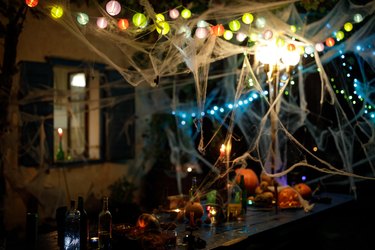
Fake spider webs are an essential element for creating every kind of spooky aesthetic, whether it's a super-scary house of horror, artsy goth Halloween decor or cutesy and kid-friendly fun for trick-or-treating. This is why inexpensive packages of fake spider webbing are always a DIY decor favorite during the Halloween season. They're incredibly versatile and easy to use, and with a little creativity, the webs can look frighteningly realistic.
Decorating with fake spider webbing is quite straightforward. You simply need to pull and stretch it into shape and secure the corners in place. The options for creative Halloween decorations using fake spider webs are endless. Create realistic spider webs in the corners, nooks and crannies of a room. You can also drape them across furniture and fixtures or create your own freestanding spider web decorations from scratch.
Video of the Day
Video of the Day
Go subtle or go big because when realistic spider webs are in view, the spooky vibe is guaranteed. After all, few things can induce a genuine tingle up the spine like a delicate wisp of cobweb brushing against unsuspecting skin! Here's our tutorial on how to create your very own DIY spider webs.
How to handle fake spider webbing
When you first open a package of fake spider webbing, the product will be compacted and not look very realistic. It will also appear to be a very small package, but rest assured that when it's sufficiently pulled apart, you should have enough fake cobwebs to decorate an entire room. All but the most ambitious, giant spider web decorations should be possible with a single package of fake spider webbing.
Start by tugging and pulling out a section of the webbing from the bundle. Use scissors to cut off a piece and continue to pull this piece into the rough cobweb shape you desire. As you work, you will get a better idea of the sizes of pieces you need to cut. Pull the piece of Halloween spider web outward in different directions until it's very thin, wispy and transparent. Secure the first two or three outer points of the web in place, pulling the web taut before securing additional outer points. Work with your fingers to loosen any thicker parts of the webbing and don't worry about any holes or tears because they make the web look more realistic. Layering multiple thin sheets of fake spider web over each other also creates a realistic, organic web.
How to secure fake spider webs
The best way to secure the outer points of your fake spider webs will depend on the surface to which you're attaching them and how comfortable you are with adhesives or small holes on those surfaces.
The following are all options for securing fake spider webs:
- Push pins
- Small nails
- Staples
- Tacky putty
- Adhesive hook-and-eye dots (the web will stick well to the rough hook side)
- Double-sided tape
- White masking tape
- Removable adhesive hooks
- Low-temperature glue gun
You might also be able to simply hook or wrap the spider webbing around corners of furniture or other decor items as well as existing hardware, such as hinges and handles.
Always add fake spiders
DIY Halloween spider webs are so much spookier when they feature a resident spider or two. Be sure to pick up some fake plastic spiders to tuck into all your spider web decorations. You could also craft your own from black construction paper, chenille sticks or other art supplies. Secure them in place with a dab of hot glue or a needle and thread. If you're not into subtle scares, dozens upon dozens of spiders might infest your web-filled decor and bring terror to all arachnophobes.
Spider web decoration ideas
A realistic haunted house that was left abandoned to fill up with spiders and ghosts would probably accumulate spider webs in the corners of the rooms; spanning the spaces between furnishings and walls; over mantels; around stair rails; and across chandeliers, lamps and ornaments. Start with this approach wherever it's appropriate for your home. Windows and the upper corners of doorways are great places for cobwebs. You might fill an entire hallway with webs as a spooky maze.
Outdoors, add spider webs to your exterior home features, such as across the corners of the front door, under awnings and across a porch. You can string cobwebs across trees and bushes, your mailbox, and other outdoor Halloween decor you have in place. Ambitious decorators might give the entire roof and house frontage the spider web treatment, complete with giant fake spiders.
Halloween crafts with spider webbing
Another option is to craft some smaller-scale spider web decorations that you can store away when it's not Halloween season. Try draping spider webbing around pumpkins and jack o' lanterns (without open flames). Make spooky jars with battery-powered faux candles or string lights inside plus a tangle of cobwebs and a family of plastic spiders. These are great for table, bookshelf and mantel decor.
If you can get your hands on a vintage-looking birdcage, adorn it with spider webs and a fake black crow. This makes an awesome centerpiece for a Halloween party table. A spider-themed Halloween wreath is fun to hang on your front door and an easy DIY project. Paint a large wooden embroidery hoop black, stretch fake spider webbing across the inner hoop and secure it with the outer hoop. Add plastic spiders and any other spooky motifs of your choice.
Ready to craft some spooky spider webs?
There's only one drawback to going all-in on fake spider webbing for your Halloween decorations. Knowing they're fake doesn't always make it less scary! You might have to overcome your own jitters over handling spiders and their spooky webs, but the cool decor will definitely be worth it come Halloween night.